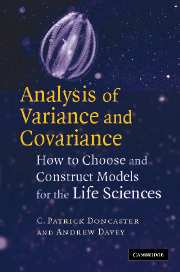Book contents
- Frontmatter
- Contents
- Preface
- Introduction to analysis of variance
- Introduction to model structures
- 1 One-factor designs
- 2 Nested designs
- 3 Fully replicated factorial designs
- 4 Randomised-block designs
- 5 Split-plot designs
- 6 Repeated-measures designs
- 7 Unreplicated designs
- Further Topics
- Choosing experimental designs
- How to request models in a statistics package
- Best practice in presentation of the design
- Troubleshooting problems during analysis
- Glossary
- References
- Index of all ANOVA models with up to three factors
- Index
- Categories of model
7 - Unreplicated designs
Published online by Cambridge University Press: 13 November 2009
- Frontmatter
- Contents
- Preface
- Introduction to analysis of variance
- Introduction to model structures
- 1 One-factor designs
- 2 Nested designs
- 3 Fully replicated factorial designs
- 4 Randomised-block designs
- 5 Split-plot designs
- 6 Repeated-measures designs
- 7 Unreplicated designs
- Further Topics
- Choosing experimental designs
- How to request models in a statistics package
- Best practice in presentation of the design
- Troubleshooting problems during analysis
- Glossary
- References
- Index of all ANOVA models with up to three factors
- Index
- Categories of model
Summary
Every model in Chapters 2 and 3 has one or more equivalents without full replication. For model 2.1 it is 1.1, for 2.2 it is 2.1, for 3.1 it is 4.1 or 6.1, for 3.2 it is 4.2 or 6.2, for 3.3 it is 5.6 or 6.3, and for 3.4 it is 3.1. Here we give two further versions of factorial models 3.1 and 3.2 without full replication. The lack of replicated sampling units means that at least one of the factors must be random, as demonstrated by model 7.1(i) below in comparison to (ii) and (iii). Factorial designs that lack full replication must further assume that there are no significant higher-order interactions between factors, which cannot be tested by the model since there is no measure of the residual error among replicate observations (subjects). This is problematic because lower-order effects can only be interpreted fully with respect to their higher-order interactions (chapter 3). Falsely assuming an absence of higher-order interactions will cause tests of lower-order effects to overestimate the Type I error (rejection of a true null hypothesis) and to underestimate the Type II error (acceptance of a false null hypothesis). Without testing for interactions, causality cannot be attributed to significant main effects, and no conclusion can be drawn about non-significant main effects. For some analyses, the existence of a significant main effect when levels of an orthogonal random block are pooled together may hold interest regardless of whether or not the effect also varies with block; the main effect indicates an overall trend averaged across levels of the random factor.
- Type
- Chapter
- Information
- Analysis of Variance and CovarianceHow to Choose and Construct Models for the Life Sciences, pp. 229 - 236Publisher: Cambridge University PressPrint publication year: 2007



